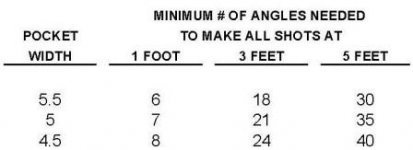Patrick Johnson said:That somebody might see two half ball hits as different shots when they're located at different places on the table is a new idea to me, but it sounds plausible, and maybe it's related to a more general idea I have about the usefulness of systems.
I think systems help generally by "organizing" aiming for shooters: dividing shots up into categories, giving step-by-step instructions for aligning the stick and balls, etc. This makes aiming a learnable process rather than an amorphous, undefined "challenge" - something that shooters can believe they're capable of mastering and approach with more confidence.
In a sense, aiming systems show shooters the "light at the end of the tunnel" so they can approach the journey through the tunnel with a more positive and productive mindset (and with fewer distractions from uncertainty).
I'm not saying this is the only thing systems do for shooters, but I think it's a fundamental benefit of systems that may underpin other benefits.
pj
chgo
(By the way, I like the word "benefits" better than "advantages" because it doesn't imply that systems are the only or best source for these things.)
If you go from no system, to a system, you're probably going to be better off. You might even think the system "works." But as PJ points out, it just helped you get organized.
From long ago:
My 2 cents
While I don't subscribe to the idea that Hal's system is as definitive
as some have described, I do believe it could be a huge help to some.
I believe that anything that helps you increase your precision and
decrease the variables in how you approach the game is a plus. Sooooo
if you use a system, such as Hal's, that helps you zero in on your
objective -- a precise hit on the object ball -- more power to you.
To me, it's sort of like someone saying there are only three points on
the vertical axis of the cue ball that you need to know for draw shots.
Well, somewhat obviously, there are more, or if you prefer, an
infinite number of hits on the cue ball to execute a draw shot. But, if
formerly you were a player that executed your draw shot by "hitting the
ball below center," using this magical "Three Point System" would
dramatically increase your draw shot precision. And, by establishing
these reference points, you can learn additional ones.
The only problem I have with Hal's system, as describe here, is that it
seems to claim there are just a handful of hits to learn. That's just
not so. But in any case, for the right level of player, I think it
could be a powerful tool.
Lou Figueroa
